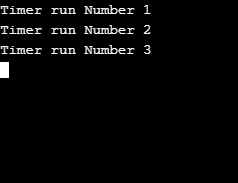
Java のタイマーは Java で使用できます。 util パッケージは Object クラスを拡張し、Serializable および Cloneable インターフェイスを実装します。 timer クラスには、タイミング関連のアクティビティを実行するために使用されるメソッドが含まれています。 Java のタイマー クラスは、時間に関連したタスクのスケジューリングを実行するために使用されます。 Java スレッドは、Timer クラスのメソッドを使用して、ある瞬間の後にコードのセクションを実行したり、事前定義された時間の後にコードを繰り返し実行したりするなどのタスクをスケジュールします。各 Timer オブジェクトは、スレッドに関連付けられたすべてのタスクの実行を担当する個別のバックグラウンド実行スレッドにバインドされます。 Java のタイマー クラスはスレッドセーフであることに注意してください。つまり、一度に 1 つのスレッドだけが Timer クラス メソッドを実行できます。また、Timer クラスは、タスクを保存するための基礎となるデータ構造としてバイナリ ヒープを利用します。
無料ソフトウェア開発コースを始めましょう
Web 開発、プログラミング言語、ソフトウェア テスト、その他
Java で Timer クラスを使用する方法の基本的な構文は次のとおりです。
構文:
// create a class extending TimerTask
class TimerHelper extends TimerTask
{
//define run method
public void run()
{
// Write Code to be executed by Timer
}
}
class MainClass{
public static void main(String[] args)
{
//create timer instance
Timer timer = new Timer();
// create Timer class instance
TimerTask task = new TimerHelper ();
// call timer method
timer.schedule(task, 3000,6000);
//first argument is timer object
// second argument is time in milliseconds after which the code will be first executed
// Third argument is time in milliseconds after which the code will be executed regularly.
}
}上記の構文の説明: この構文は、Java で Timer クラスがどのように使用されるかを示しています。タイマー クラスを使用するには、TimerTask を拡張するクラスを作成し、その中で run メソッドを定義する必要があります。 run メソッドには、時間駆動ベースで実行する必要があるロジックが含まれています。以下は Timer クラスの宣言です:
public class Timer extends Object implements Serializable, Cloneable
ここで、Java Timer クラスで使用できるさまざまなメソッドとフィールドが何であるかを見ていきます。 Timer クラスで使用できる一般的に使用されるメソッドのリストは次のとおりです:
| Method Name | Description |
| public void schedule(TimerTask task, Date date) | Schedules a task to be executed on the defined date. |
| public void schedule (TimerTask task, Date firstTime, long timeperiod) | The first argument is TimerTask to be executed; the second argument is the time after which the task is executed for the first time, and the third argument is seconds in milliseconds after which task will be executed regularly. |
| public int purge() | Used for removing all canceled tasks from the timer’s queue. |
| public void cancel() | Cancel’s the timer. |
| public void schedule(TimeTask task, long delay) | Schedules the task to be executed after the specified time in milliseconds. |
| public void schedule(TimeTask task, long delay, long period) | The first argument is TimerTask to be executed; the second argument is the time in milliseconds after which task is executed for the first time, and the third argument is seconds in milliseconds after which task will be executed regularly. |
| public void scheduleAtFixedRate(TimerTask task, Date firstTime, long timeperiod) | The first argument is TimerTask to be executed; the second argument is the time after which the task is executed for the first time, and the third argument is seconds in milliseconds after which the task will be executed regularly. |
| public void scheduleAtFixedRate (TimeTask task, long delay, long period) | The first argument is TimerTask to be executed; the second argument is the time in milliseconds after which task is executed for the first time, and the third argument is seconds in milliseconds after which task will be executed regularly. |
From the above-stated methods, we have found two methods that are similar in working but different in the name; they are schedule and scheduleAtFixedRate. The difference between the two is that in the case of fixed-rate execution, each execution is scheduled in accordance with the initial execution. If there is a delay in execution, then two or more executions will occur in quick succession to overcome the delay.
The timer class contains four constructors for instantiating timer object.
One of the above four listed constructors can be called depending on our requirements.
Below is the example of Timer in Java:
To start things, let us see a basic example of Timer class. In this example, we will demonstrate the use of the schedule method of the Timer class.
Code:
package com.edubca.timer;
import java.util.Timer;
import java.util.TimerTask;
class TimerHelper extends TimerTask
{
public static int counter = 0;
public void run()
{
counter++;
System.out.println("Timer run Number " + counter);
}
}
public class Main
{
public static void main(String[] args)
{
Timer timer = new Timer();
TimerTask timerhelper = new TimerHelper();
timer.schedule(timerhelper, 3000, 2000);
}
}Explanation of the above code: The above code will execute the run method for the first time after 3 seconds as the first argument is 3000, and after every 2 seconds, the run method will be executed regularly. Here is the output that will be displayed:
Output:

In this example, we will see how to terminate a timer thread after a given number of timer runs.
Code:
package com.edubca.timer;
import java.util.Timer;
import java.util.TimerTask;
class TimerHelper extends TimerTask
{
public static int counter = 0;
public void run()
{
counter++;
if(counter ==3){
this.cancel();
System.out.println("Now Cancelling Thread!!!!!");
return;
}
System.out.println("Timer run Number " + counter);
}
}
public class Demo
{
public static void main(String[] args)
{
Timer timer = new Timer();
TimerTask helper = new TimerHelper();
helper.schedule(task, 3000, 2000);
}
}In the above example, the timer will cancel after the three times run method is called using the timer class’s cancel method.
Output:

以上がJavaのタイマーの詳細内容です。詳細については、PHP 中国語 Web サイトの他の関連記事を参照してください。